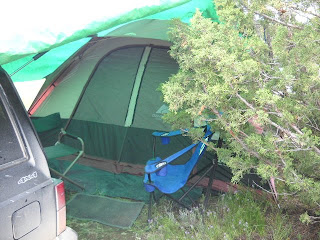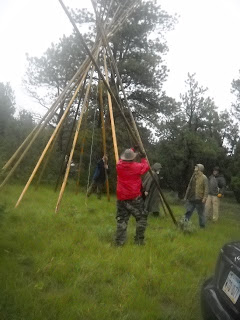 Dirt Time 2010 was quickly dubbed "Mud Time 2010", at least until the sun came out on the 3rd day!
Dirt Time 2010 was quickly dubbed "Mud Time 2010", at least until the sun came out on the 3rd day!We arrived at the site around 11:00 Sunday morning. We checked in at (where else?) the check-in tent and got our official Dirt Time 2010 Goodie Bag donated by Survival Resources (Oh cool, look! A write-in-the-rain notebook! And a whistle!), and picked a place to set up our tent (where we could blow our whistle periodically in the night and use the little notebook to record the comments of fellow campers!)(The didn't give us a pen, though!) The check-in lady said it had been windy and advised us to set up camp among the trees. After looking upward 30' for trees at the height we were accustomed to in Montana, we took it to mean that the 10' Junipers were the referred-to trees. (Inside joke. A little Montana/Wyoming rivalry!)
I sniped at my husband about the huge tent he had insisted on bringing. All that space, for two people? And cots!!! I'd never slept on a cot before while camping! We inherited these along with the rest of my Dad's camping and fishing stuff when he passed away last year. I was in wonder, though, after this big tent with it's huge screened windows was set up, and there were our "beds", up off the ground! Wow! Which way to the parlor?
 We went ahead and put up the huge tarp, from behind the tent, up and over, across about an 8' sitting area, and onto the roof of our Jeep Cherokee, where we tied and bungeed the whole thing down. We ran a ridgepole rope from the trees on each side, under the tarp about midway, so it wouldn't sag. What a great breezeway, with our folding chairs spread out and the cooler parked there!
We went ahead and put up the huge tarp, from behind the tent, up and over, across about an 8' sitting area, and onto the roof of our Jeep Cherokee, where we tied and bungeed the whole thing down. We ran a ridgepole rope from the trees on each side, under the tarp about midway, so it wouldn't sag. What a great breezeway, with our folding chairs spread out and the cooler parked there!
I apologized to Steven and decided to enjoy the luxury...especially when the deluge of rain began two hours later and continued unabated for 2 straight days! Nice, then, to NOT be against the walls of a small tent, to be off the ground, and to have the sitting area to spread out to!
We wandered up through the woods to find the Mess tent and bathrooms. There were actual pine trees up there, the 30' kind, so I ate my humble pie and stopped snickering about Wyoming trees! There were a few dozen people already there, milling around. Among the first we met were John and Denise McCann. They own "Survival Resources", which sells supplies for your BOBs ("Bug out bags"), backpacks, or even to keep in your home or car, as well as teaching survival skills workshops in New York State (http://www.bepreparedtosurvive.com/). Wonderful people. More about them later.
The Mess tents were two 10' by 20' tents, like Costco sells and some people use for carports. The 3-person cooking crew used one for cooking and the other for the serving line. Tarps were strung between trees to privide shelter, and boards were laid across spools from the power copmany to provide "tables". Soup was served for lunch, though officially there was no meal until evening!
Around 1:00 it started raining. It kept raining. Everything quickly got muddy. The gound did not absorb water. It turned the top several inches into thick gumbo mud. New arrivals were getting stuck in the mud, and volunteers went to pull cars and trucks out of the mud. Finally it got so bad that some rigs were left out in the mud, and their gear was transported the rest of the way in other people's trucks.
We had raincoats but no boots. I tied plastic grocery bags over my shoes and up around my lower legs, to try and keep my feet dry. Some who didn't have raincoats took large garbage bags and made ponchos. I would have cut a hole in the top and stuck my head through, but some of these people were smarter than me! Like John McCann. He said you make a hole along one edge, with the top edge of the hole a few inches from the bottom of the bag, and Ta-Da! You have a hooded poncho! (You'll see a picture of it later on this blog!)





























